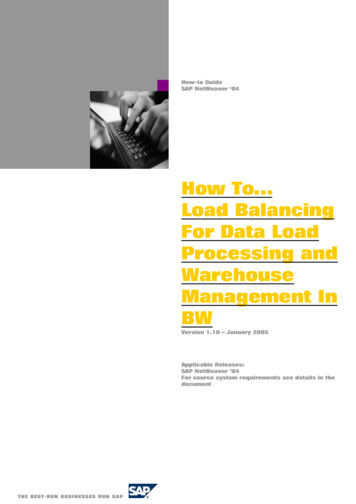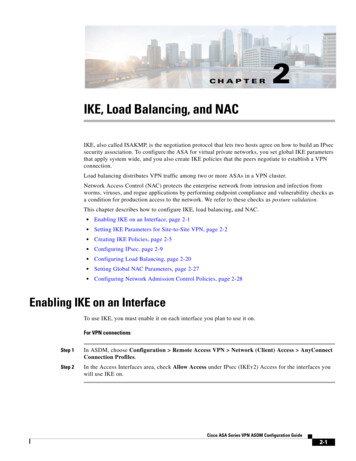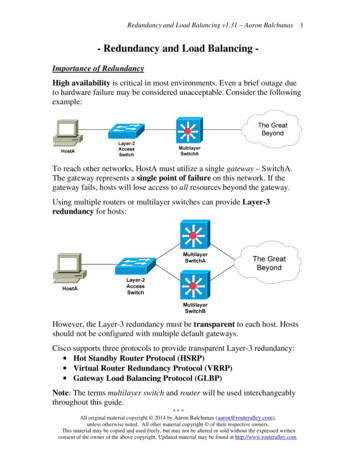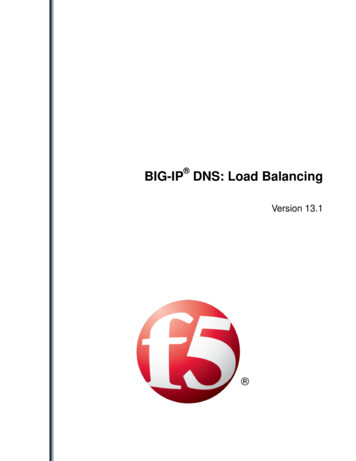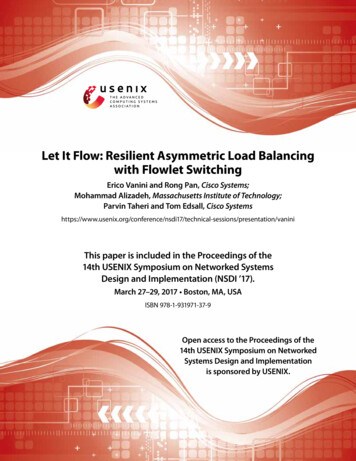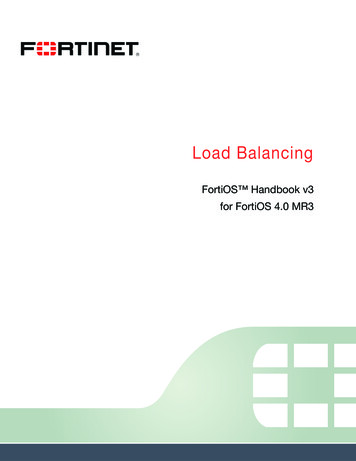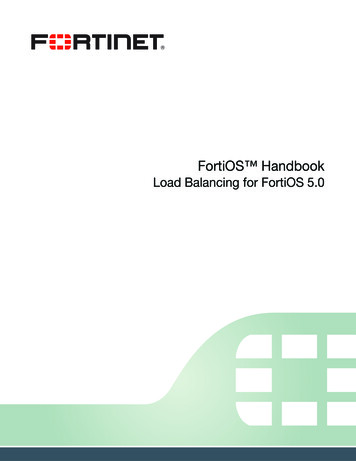
Transcription
White PaperLoad Balancing 101:Nuts and BoltsLoad balancing technology is the basis on which today’sApplication Delivery Controllers operate. But thepervasiveness of load balancing technology does notmean it is universally understood, nor is it typicallyconsidered from anything other than a basic, networkcentric viewpoint. To maximize its benefits, organizationsshould understand both the basics and nuances ofload balancing.by KJ (Ken) Salchow, Jr.Sr. Manager, Technical Marketing and Syndication
White PaperLoad Balancing 101: Nuts and BoltsContentsIntroduction3Basic Load Balancing Terminology3Node, Host, Member, and Server3Pool, Cluster, and Farm4Virtual Server5Putting It All Together5Load Balancing Basics6The Load Balancing Decision7To Load Balance or Not to Load Balance?9Conclusion102
White PaperLoad Balancing 101: Nuts and BoltsIntroductionLoad balancing got its start in the form of network-based load balancinghardware. It is the essential foundation on which Application Delivery Controllers(ADCs) operate. The second iteration of purpose-built load balancing (followingapplication-based proprietary systems) materialized in the form of network-basedappliances. These are the true founding fathers of today’s ADCs. Because thesedevices were application-neutral and resided outside of the application serversthemselves, they could load balance using straightforward network techniques.In essence, these devices would present a “virtual server” address to the outsideworld, and when users attempted to connect, they would forward the connectionto the most appropriate real server doing bi-directional network addresstranslation (NAT).Host: 172.16.1.11Services: 172.16.11.80ClientInternetVirtual ServerHost: 172.16.1.12Services: 172.16.12.80192.0.2.1:80Web ClusterFigure 1: Network-based load balancing appliances.Basic Load Balancing TerminologyIt would certainly help if everyone used the same lexicon; unfortunately, everyvendor of load balancing devices (and, in turn, ADCs) seems to use differentterminology. With a little explanation, however, the confusion surrounding thisissue can easily be alleviated.Node, Host, Member, and ServerMost load balancers have the concept of a node, host, member, or server; somehave all four, but they mean different things. There are two basic concepts that theyall try to express. One concept—usually called a node or server—is the idea of thephysical server itself that will receive traffic from the load balancer. This is3
White PaperLoad Balancing 101: Nuts and Boltssynonymous with the IP address of the physical server and, in the absence ofa load balancer, would be the IP address that the server name (for example,www.example.com) would resolve to. For the remainder of this paper, we willrefer to this concept as the host.The second concept is a member (sometimes, unfortunately, also called a node bysome manufacturers). A member is usually a little more defined than a server/nodein that it includes the TCP port of the actual application that will be receiving traffic.For instance, a server named www.example.com may resolve to an address of172.16.1.10, which represents the server/node, and may have an application (a webserver) running on TCP port 80, making the member address 172.16.1.10:80. Simplyput, the member includes the definition of the application port as well as the IPaddress of the physical server. For the remainder of this paper, we will refer to thisas the service.Why all the complication? Because the distinction between a physical server and theapplication services running on it allows the load balancer to individually interactwith the applications rather than the underlying hardware. A host (172.16.1.10) mayhave more than one service available (HTTP, FTP, DNS, and so on). By defining eachapplication uniquely (172.16.1.10:80, 172.16.1.10:21, and 172.16.1.10:53), the loadbalancer can apply unique load balancing and health monitoring (discussed later)based on the services instead of the host. However, there are still times when beingable to interact with the host (like low-level health monitoring or when taking aserver offline for maintenance) is extremely convenient.Remember, most load balancing-based technology uses some concept to representthe host, or physical server, and another to represent the services available on it—in this case, simply host and services.Pool, Cluster, and FarmLoad balancing allows organizations to distribute inbound traffic across multipleback-end destinations. It is therefore a necessity to have the concept of a collectionof back-end destinations. Clusters, as we will refer to them herein, although alsoknown as pools or farms, are collections of similar services available on any numberof hosts. For instance, all services that offer the company web page would becollected into a cluster called “company web page” and all services that offere-commerce services would be collected into a cluster called “e-commerce.”4
White PaperLoad Balancing 101: Nuts and BoltsThe key element here is that all systems have a collective object that refers to“all similar services” and makes it easier to work with them as a single unit. Thiscollective object—a cluster—is almost always made up of services, not hosts.Virtual ServerAlthough not always the case, today there is little dissent about the term virtualserver, or virtual. It is important to note that like the definition of services, virtualserver usually includes the application port was well as the IP address. The term“virtual service” would be more in keeping with the IP:Port convention; but becausemost vendors use virtual server, this paper will continue using virtual server as well.Putting It All TogetherPutting all of these concepts together makes up the basic steps in load balancing.The load balancer presents virtual servers to the outside world. Each virtual serverpoints to a cluster of services that reside on one or more physical hosts.Host: 172.16.1.11Services: 172.16.11.80Host: 172.16.1.12Services: 172.16.12.80ClientInternetVirtual ServerWeb Cluster: 192.0.2.1:80SSL Cluster: 192.0.2.1:443Telnet Cluster: 192.0.2.1:23Host: 172.16.1.13Services: 172.16.13.80172.16.1.13.443Host: 172.16.1.14Services: 172.16.12.80SSL Cluster:172.16.1.13:443Web ClusterWeb Telnet Cluster:172.16.1.14:23Figure 2: Load balancing comprises four basic concepts—virtual servers, clusters, services,and hosts.5
White PaperLoad Balancing 101: Nuts and BoltsWhile Figure 2 may not be representative of any real-world deployment, itdoes provide the elemental structure for continuing a discussion about loadbalancing basics.Load Balancing BasicsWith this common vocabulary established, let’s examine the basic load balancingtransaction. As depicted, the load balancer will typically sit in-line between theclient and the hosts that provide the services the client wants to use. As with mostthings in load balancing, this is not a rule, but more of a best practice in a typicaldeployment. Let’s also assume that the load balancer is already configured witha virtual server that points to a cluster consisting of two service points. In thisdeployment scenario, it is common for the hosts to have a return route that pointsback to the load balancer so that return traffic will be processed through it on itsway back to the client.The basic load balancing transaction is as follows:1. The client attempts to connect with the service on the load balancer.2. The load balancer accepts the connection, and after deciding which hostshould receive the connection, changes the destination IP (and possibly port)to match the service of the selected host (note that the source IP of the clientis not touched).3. The host accepts the connection and responds back to the original source,the client, via its default route, the load balancer.4. The load balancer intercepts the return packet from the host and now changesthe source IP (and possible port) to match the virtual server IP and port, andforwards the packet back to the client.5. The client receives the return packet, believing that it came from the virtualserver, and continues the process.6
White PaperLoad Balancing 101: Nuts and BoltsVirtual ServerLoad Balancer to HostClient: 198.18.0.1:5000 - 172.16.1.11:80 SYNServer: 172.16.1.11:80 - 198.18.0.1:5000 SYN/ACKClient: 198.18.0.1:5000 - 172.16.1.11:80 ACK192.0.2.1:80BIG-IPLocal Traffic ManagerClientHost: 172.16.1.11Services: 172.16.11.80198.18.0.1InternetBIG-IPLocal Traffic ManagerHost: 172.16.1.12Services: 172.16.12.80Client to Virtual ServerClient: 198.18.0.1:5000 - 192.0.2.1:80 SYNServer: 192.0.2.1:80 - 198.18.0.1:5000 SYN/ACKClient: 198.18.0.1:5000 - 192.0.2.1:80 ACKWeb ClusterDefault Route: 172.16.1.1Figure 3: A basic load balancing transaction.This very simple example is relatively straightforward, but there are a couple of keyelements to take note of. First, as far as the client knows, it sends packets to thevirtual server and the virtual server responds—simple. Second, the NAT takes place.This is where the load balancer replaces the destination IP sent by the client (of thevirtual server) with the destination IP of the host to which it has chosen to loadbalance the request. Step three is the second half of this process (the part thatmakes the NAT “bi-directional”). The source IP of the return packet from the hostwill be the IP of the host; if this address were not changed and the packet wassimply forwarded to the client, the client would be receiving a packet from someoneit didn’t request one from, and would simply drop it. Instead, the load balancer,remembering the connection, rewrites the packet so that the source IP is that ofthe virtual server, thus solving this problem.The Load Balancing DecisionUsually at this point, two questions arise: how does the load balancer decide whichhost to send the connection to? And what happens if the selected host isn’t working?Let’s discuss the second question first. What happens if the selected host isn’tworking? The simple answer is that it doesn’t respond to the client request and theconnection attempt eventually times out and fails. This is obviously not a preferredcircumstance, as it doesn’t ensure high availability. That’s why most load balancingtechnology includes some level of health monitoring that determines whether a hostis actually available before attempting to send connections to it.7
White PaperLoad Balancing 101: Nuts and BoltsThere are multiple levels of health monitoring, each with increasing granularityand focus. A basic monitor would simply PING the host itself. If the host does notrespond to PING, it is a good assumption that any services defined on the hostare probably down and should be removed from the cluster of available services.Unfortunately, even if the host responds to PING, it doesn’t necessarily meanthe service itself is working. Therefore most devices can do “service PINGs” ofsome kind, ranging from simple TCP connections all the way to interacting withthe application via a scripted or intelligent interaction. These higher-level healthmonitors not only provide greater confidence in the availability of the actual services(as opposed to the host), but they also allow the load balancer to differentiatebetween multiple services on a single host. The load balancer understands thatwhile one service might be unavailable, other services on the same host might beworking just fine and should still be considered as valid destinations for user traffic.This brings us back to the first question: How does the load balancer decide whichhost to send a connection request to? Each virtual server has a specific dedicatedcluster of services (listing the hosts that offer that service) which makes up the list ofpossibilities. Additionally, the health monitoring modifies that list to make a list of“currently available” hosts that provide the indicated service. It is this modified listfrom which the load balancer chooses the host that will receive a new connection.Deciding the exact host depends on the load balancing algorithm associated withthat particular cluster. The most common is simple round-robin where the loadbalancer simply goes down the list starting at the top and allocates each newconnection to the next host; when it reaches the bottom of the list, it simplystarts again at the top. While this is simple and very predictable, it assumes thatall connections will have a similar load and duration on the back-end host, whichis not always true. More advanced algorithms use things like current-connectioncounts, host utilization, and even real-world response times for existing traffic tothe host in order to pick the most appropriate host from the available cluster services.Sufficiently advanced load balancing systems will also be able to synthesize healthmonitoring information with load balancing algorithms to include an understandingof service dependency. This is the case when a single host has multiple services,all of which are necessary to complete the user’s request. A common examplewould be in e-commerce situations where a single host will provide both standardHTTP services (port 80) as well as HTTPS (SSL/TLS at port 443). In many of thesecircumstances, you don’t want a user going to a host that has one serviceoperational, but not the other. In other words, if the HTTPS services should failon a host, you also want that host’s HTTP service to be taken out of the clusterlist of available services. This functionality is increasingly important as HTTP-likeservices become more differentiated with XML and scripting.8
White PaperLoad Balancing 101: Nuts and BoltsTo Load Balance or Not to Load Balance?Load balancing in regards to picking an available service when a client initiates atransaction request is only half of the solution. Once the connection is established,the load balancer must keep track of whether the following traffic from that usershould be load balanced. Th
physical server itself that will receive traffic from the load balancer. This is 3. 4 White Paper Load Balancing 101: Nuts and Bolts synonymous with the IP address of the physical server and, in the absence of a load balancer, would be the IP address that the server name (for example, www.example.com) would resolve to. For the remainder of this paper, we will refer to this concept as the host .

